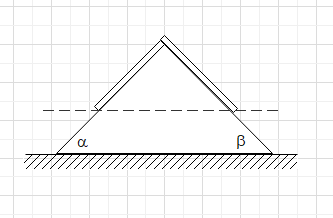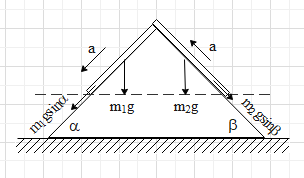Question
Question: A uniform rope of length L and mass M is placed on a smooth fixed wedge as shown. Both ends of rope ...
A uniform rope of length L and mass M is placed on a smooth fixed wedge as shown. Both ends of rope are at the same horizontal level. The rope is initially released from rest, then the magnitude of initial acceleration of the rope is

Solution
To solve this question, first find the component of the forces acting on the ropes on both sides and then equate them to find the equation. Add the equations for both sides of the rope to find the initial acceleration acting on the rope.
Complete step-by-step answer:
The length of the rope on the left side is L1 and on the right side is L2. The total length of the rope is L.
L=L1+L2
Total mass of the rope is M.
The mass per unit length of the rope is LM
So, the mass of the rope on the left side is m1=L1LM
Mass of the rope on the right side is m2=L2LM

Weight of the rope on the left side is, m1g=LL1Mg
Weight of the rope on the right side is, m2g=LL2Mg
Now, taking the component of the forces on the ropes,
On the left side of the rope,
m1gsinα−T=m1aLL1Msinα−T=LL1Ma
And, on the right side of the rope,
T−m2gsinβ=m2aT−LL2Mgsinβ=LL2Ma
Adding the above two equations,
LL1Mgsinα−LL2Mgsinβ=LL1Ma+LL2Ma(L1sinα−L2sinβ)g=(L1+L2)a=Laa=a(L1sinα−L2sinβ)g
Now, since both ends of the rope are in the same horizontal line or in the same vertical height, the components,
L1sinα=L2sinβ
So, we can write,
a=0
So, the correct answer is “Option A”.
Note: In the above question, the angles of the triangle are different from each other and also the lengths of the rope on the both sides are also different. But then also the components in the vertical directions are equal to each other because the both ends of the rope are in the same horizontal plane or in the same vertical height.
